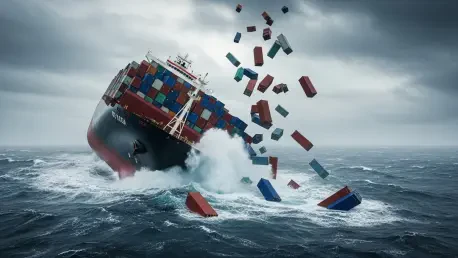Imagine a bustling port, a critical hub of global trade, suddenly thrown into chaos as a massive cargo ship tilts unexpectedly, sending dozens of shipping containers tumbling into the water. This startling scene unfolded at the Port of Long Beach, California, one of the busiest ports in the United States, when the vessel Mississippi encountered a rare mishap at Pier G. On September 9, an alarming incident led to the loss of 95 containers, captivating attention due to its complexity and the sheer scale of the recovery effort required. This event tested the resilience of port operations and highlighted the importance of swift, coordinated action in the face of maritime challenges.
Incident at Pier G: A Shocking Container Loss
The Portugal-registered Mississippi, arriving from Yantian, China, faced an unforeseen disaster shortly after docking at Pier G. The ship listed abruptly, causing multiple rows of containers to collapse into the harbor. Initial reports estimated a loss of 75 containers, but as salvage teams delved deeper, they uncovered additional units—some crushed, others submerged or hidden in the nearby boat basin—bringing the total to 95. This rare occurrence disrupted normal operations at a port that handles millions of containers annually, underscoring the urgency of a robust response.
The significance of this incident lies not only in the number of containers lost but also in the potential risks to safety and trade flow. As a vital gateway for goods entering and exiting the United States, any disruption at Long Beach reverberates across supply chains. The event quickly became a focal point for maritime experts, prompting questions about vessel stability, loading practices, and emergency preparedness in such high-traffic environments.
Recovery Operation Unfolds: A Race Against Time
Under the leadership of the Unified Command, spearheaded by the U.S. Coast Guard, a meticulous salvage operation launched to retrieve all 95 containers. The effort culminated successfully on a Friday afternoon at approximately 3:28 p.m., when the final container was hoisted from the water. Despite the scale of the challenge, the operation minimized disruption to port activities, showcasing a blend of strategic planning and adaptability in a high-stakes environment.
Safety remained the cornerstone of every decision, as emphasized by Coast Guard Capt. Stacey Crecy, who served as the incident commander. From managing underwater hazards to coordinating vessel movements, the team prioritized protecting personnel and maintaining operational continuity. The safety zone around the Mississippi was initially set at 500 yards but later reduced to 100 yards as recovery progressed, with all traffic restrictions lifted by September 26 after dive operations wrapped up.
Remarkably, port operations continued with minimal interruption, with 142 vessel transits authorized during the salvage phase. By Sunday, the Mississippi departed Long Beach, bound for Vietnam, as confirmed by AIS data. Pier G terminal operations have since returned to normal, with unrestricted port traffic signaling a return to routine amidst an extraordinary recovery effort.
Safety as the Bedrock of Response
At the heart of the salvage operation was an unwavering commitment to safety, guiding every action taken in the harbor. Divers faced treacherous underwater conditions to locate and retrieve submerged containers, while strict protocols ensured their protection against potential hazards. The focus on safeguarding personnel extended to every facet of the response, balancing the need for speed with caution.
Coordinating vessel transits within the designated safety zone required precise oversight to prevent accidents. The phased reduction of the safety perimeter demonstrated a calculated approach, ensuring that as risks diminished, port functionality could be restored. This emphasis on safety not only protected lives but also preserved confidence in the port’s ability to manage crises effectively.
Teamwork Triumphs: A Unified Effort
Collaboration emerged as a defining feature of the recovery process, uniting diverse groups under a shared goal. Port of Long Beach incident commander Michael Goldschmidt commended the seamless partnership between the Coast Guard, vessel managers, salvage experts, and workers from the International Longshore and Warehouse Union (ILWU). Their combined skills and dedication turned a daunting challenge into a model of efficiency.
Each team brought unique expertise to the table, from logistical planning to hands-on recovery tasks. This synergy enabled rapid problem-solving in the face of a rare incident, setting a precedent for how complex maritime emergencies can be addressed. The spirit of cooperation highlighted the strength of collective action in overcoming obstacles at a critical trade hub.
On-the-Ground Efforts: Divers and Tactical Maneuvers
The physical demands of the recovery were immense, with dive teams at the forefront inspecting the Mississippi’s hull for damage and identifying trapped containers. Working in murky waters, these skilled professionals navigated significant risks to ensure no unit was left behind. Their efforts provided the foundation for a thorough and successful salvage.
Tugs and pilot vessels played a crucial role in repositioning the ship to access hard-to-reach containers, executing precise maneuvers under tight constraints. The operation demanded adaptability, as teams adjusted to evolving conditions and learned from each step of this uncommon event. This hands-on work painted a vivid picture of determination and grit in action.
Cutting-Edge Tools: Technology in Salvage
Advanced technology proved indispensable in overcoming the challenges of locating submerged containers in low-visibility conditions. Side-scan sonar mapped the harbor floor, pinpointing the exact locations of lost units, while remotely operated vehicles provided visual confirmation without endangering divers. These tools streamlined the search process significantly.
The integration of such innovations not only expedited recovery but also set a benchmark for future maritime salvage operations. By leveraging state-of-the-art equipment, the teams demonstrated how technology can address logistical hurdles in crisis situations. This approach ensured efficiency while maintaining the highest safety standards throughout the mission.
Reflections on Resilience: Lessons from the Incident
Looking back, the recovery of all 95 containers at the Port of Long Beach stood as a testament to meticulous planning and unwavering teamwork. The operation’s success in balancing safety with operational continuity offered valuable insights into managing rare maritime incidents. As investigations by the U.S. Coast Guard and the National Transportation Safety Board continued, the focus shifted toward understanding the root cause to prevent future occurrences.
Moving forward, the incident emphasized the need for enhanced preparedness and investment in technology to bolster port resilience. Strengthening training programs for emergency response and refining vessel loading protocols could mitigate similar risks down the line. The collaborative framework established during this event should serve as a blueprint for other ports, ensuring that global trade hubs remain robust against unexpected disruptions.









